Operating principle of a typical dishwasher: design, main components, operating rules
There are quite a few PMM models for the kitchen.Moreover, each manufacturer of dishwashing equipment strives to stand out from the rest: some add various sensors to the design of the dishwasher, while others add new units with additional functions.
But, regardless of the brand, the general operating principle of a household-class dishwasher is the same. The main operating units of equipment under different brands are also similar. How does a dishwasher work and on what principle does it work? It is these questions that we will examine in detail in this material. We will also consider basic recommendations for operating dishwashers.
The content of the article:
Dishwasher components
Most of the automatic dishwashers currently offered in stores are models built into kitchen units with frontal (vertical) loading of dishes. This technique simplifies the life of a housewife as much as possible.
I put dirty cutlery into the machine, pressed the button - and after a while the spoons, forks and plates were clean again.
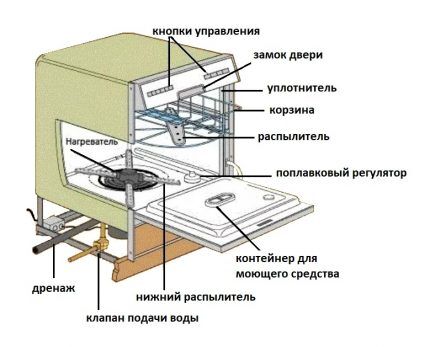
In order for the dishwasher to work properly and wash dishes thoroughly, the machine requires water that regenerates salt and detergents. In this case, the water jets must have a set temperature, the salt composition must meet the requirements for NaCl purity, and liquids and washing tablets must be suitable for the specific model.
Each dishwasher unit is responsible for its part of the dishwashing process. If the heating element does not heat the water sufficiently, the pump does not pump it completely, and the ion exchanger or filters become clogged, then the dishes will remain dirty. You will have to stand at the sink and finish the operation of the machine manually. But then why buy a dishwasher at all?
Main components of household PMM
The small body of the dishwasher contains the following working units:
- Circulation pump for water supply.
- Drain pump for pumping waste into the sewer.
- Ion exchanger with resin to soften hard water.
- Instantaneous water heater (heating element with safety thermostat).
- Temperature and liquid level sensors inside.
- Filter for cleaning wastewater from food residues.
- Filter for purifying water supplied to the machine.
- Internal washing chamber with several baskets for different dishes.
- Upper and lower sprinklers (rocker arms with nozzles).
- Display and operating mode selection panel.
- Control block.
Plus, some models are equipped with a heat exchanger, and some with a fan for drying washed dishes.

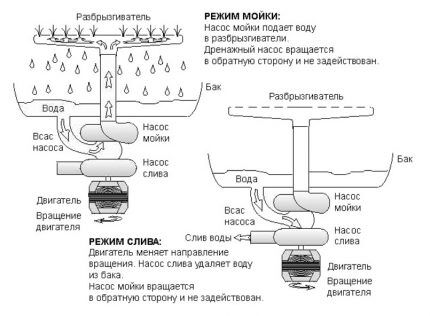
The chamber for dishes is made of stainless steel. To reduce noise, a rubber seal runs along the contour of the hatch door. The cutlery trays are made removable.This allows you to place not only small dishes inside the dishwasher, but also more frying pans or pots.
On the door there is a container for detergent (liquid, powder or tablets). Another reservoir is made at the bottom of the chamber - this is for regenerating salt in the ion exchanger.
On the front of the dishwasher there are machine status indicators or a display, as well as a touch or mechanical control panel. The display-touch version is the most convenient to use, but also the most expensive. At the same time, simpler mechanics in the form of a round handle will last much longer in the vast majority of cases.
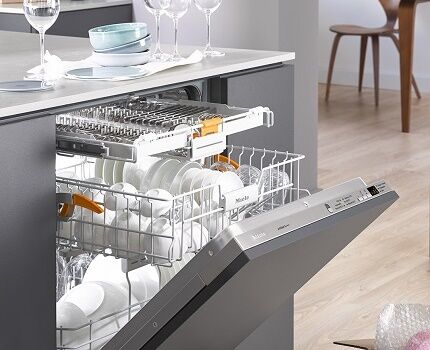
A typical dishwasher also includes:
- power cable;
- hoses for draining dirty water and supplying clean water;
- shelves, baskets and trays for dishes.
Special salt and cleaning compounds are consumables. They are not included in the kit, but you should not turn on the dishwasher without them.
Water alone still won’t wash dishes well. Plus, the automatic dishwasher is initially configured to have these products inside. If there are none or they are in insufficient quantities, the machine will not work and the protection will work. We have provided recommendations for choosing the most effective dishwashing detergent in this publication.
Additional elements and devices
The operation of the PMM is controlled by the corresponding automation unit. It sends signals to pumps, heating elements and valves. However, he needs sensors that monitor what is happening inside the operating equipment.And here each manufacturer himself determines the required set of sensors.
There is always one sensor in the car - a water temperature meter. Without it, it is impossible to maintain the proper temperature in the washing chamber. Plus, he also makes sure that the heating element does not overheat.
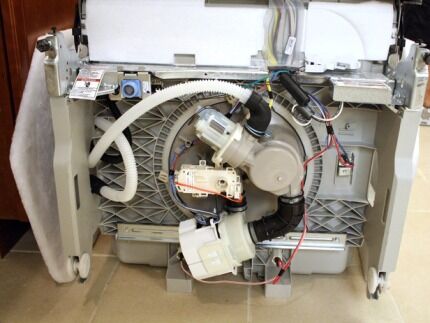
All these sensors are needed to improve the efficiency of the automatic PMM. The more the control unit knows about what is happening inside the chamber with the dishes, the better it is able to select the washing mode.
How is dishwasher drying implemented?
Another additional unit is associated with drying washed cutlery. Almost all models of such machines require such a function. Only the most inexpensive options come without this option.
To dry dishes, the dishwasher is equipped with:
- heat exchanger;
- fan with heating coil;
- block with zeolite.
The first option is a plastic tank inside the PMM. It is filled with cold water and, through simple heat exchange processes, removes excess moisture from the chamber when needed.
After washing is completed, water begins to evaporate from the dishes and settle in the form of condensation just on this heat exchanger and the inner walls of the washing machine. The process is quite lengthy, but such a unit does not require electricity to operate.
The second option is energy dependent, but dries dishes much faster. However, the spinning fan is a little noisy.When choosing a dishwasher with it, you need to make sure that the seal on the hatch performs not only the functions of preventing leaks, but also sound insulation. The lid should close as tightly as possible.
The third option is a new product of the latest generation, which not all manufacturers have in their lineup yet. When absorbing water, the zeolite mineral heats up and releases heat in the form of dry heated air.
This hot air flow is used to dry washed kitchen utensils. Such equipment consumes almost a third less electricity than its counterpart with a fan. Moreover, there is no need to change or add zeolite. It gradually recovers itself and gets rid of excess moisture.

Dishwasher manufacturers are constantly adding new options to their models to attract buyers. The search for solutions to improve the efficiency of this technology is ongoing. Moreover, the more such additional modules, the greater the likelihood of PMM failure.
We examined each of the main working nodes in more detail in our article: The structure of a typical dishwasher: design, purpose and maintainability of various parts.
The importance of salt ion exchange
A distinction must be made between detergent and regenerating sodium salt for PMM. These are two different formulations that are poured into different dishwasher containers. “Soap” goes into a reservoir on the lid, and “sodium” is poured into a container at the bottom of the washing chamber.
There are also all-in-one tablets. They are placed in a compartment on the machine hatch and already contain the required volumes of saline solution. But if the water in the tap is very hard, with a high content of magnesium and calcium, then it will be difficult to do without salt specially designed for the ion exchanger. Without it, the PMM will inevitably and quite quickly break down in such a situation.
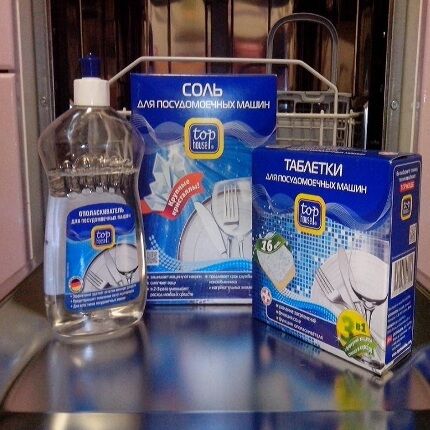
The PMM contains an ion exchanger with a resin consisting of sodium chloride NaCl. The entire flow from the water supply for washing first passes through this block, where calcium and magnesium in the water are replaced by sodium ions. As a result, the formation of scale on the parts of the dishwasher and stains on the dishes is eliminated.
Gradually Na is washed out of the ion exchanger and must be replaced with a new portion. Moreover, you cannot use a regular food analogue for this. As a last resort, it is permissible to use coarse-crystalline boiled salt of the “EXTRA” group. But it is best to use only formulations specially prepared for dishwashers with a NaCl content of more than 99%.
The rate of salt consumption is determined by the dishwasher settings. In many PMM models, this process must be adjusted manually using a special table. Moreover, during further operation you will have to constantly monitor the composition of the water and adjust the adjustment.
To save yourself from such a routine, immediately upon purchase choose equipment with a hardness sensor. This way the machine will adjust itself, and NaCl consumption will be as economical as possible. We have more recommendations for choosing a dishwasher brought here.
How dishwashers work
To understand how a dishwasher works inside, you do not need to have any special knowledge of high sciences. The operation of an automatic dishwasher is based on the principle of a step-by-step process - first one cycle is performed, then the second, third, etc., and at the end clean cutlery is taken out of the machine.
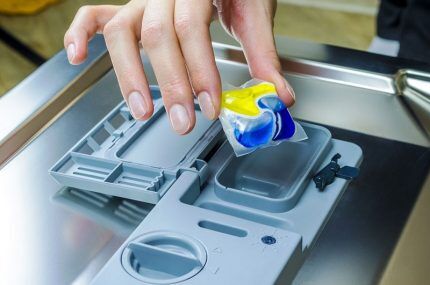
Washing dishes in a PMM occurs in four stages:
- Pre-soaking (rinsing off large food residues).
- Main washing cycle.
- Rinse.
- Drying.
First, large remnants of uneaten food are removed from the surface of the dish. Then the temperature in the PMM increases and the main washing begins with the addition of detergents. This happens cyclically - collecting and heating water, spraying it around the chamber, draining it into the drain. The number of repetitions of this process depends on the selected washing mode. We talked in more detail about the washing cycle and the duration of the main modes in this material.
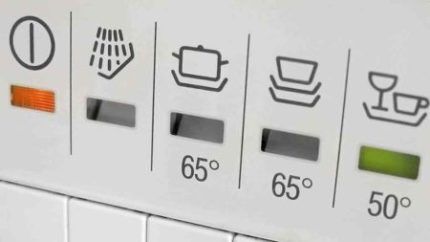
Finally, the dishes are rinsed with clean water and dried. If the machine comes with a heat exchanger, then the last stage may take several tens of minutes. If you have a drying fan or a module with zeolite, this happens much faster.
To ensure that water washes all parts of the dishes folded for washing, without exception, the sprinklers constantly rotate during operation.These rocker arms have several nozzles directed to the sides at different angles. The more nozzles there are and, accordingly, the number of jets in the chamber, the faster and more thoroughly the cutlery is washed.
Rules for using a household dishwasher
Tablets, liquids and powders intended for dishwashers contain a minimum of foaming components. The abundance of foam only harms the process of washing dishes in the PMM. The less it is, the better. Therefore, you cannot use regular soap or anything similar in the dishwasher.
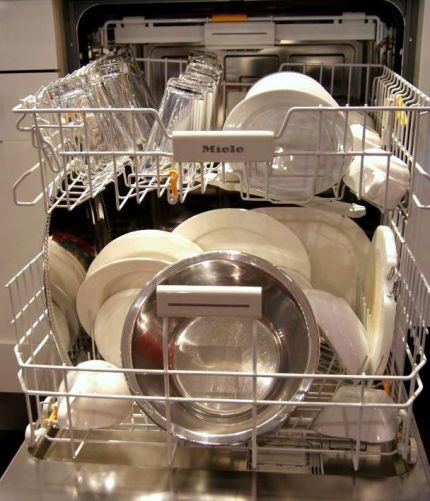
Not all cutlery can be washed in the PMM. Drying with hot air is contraindicated for plastic. The plate from it will at least soften, and maybe “leak” with plastic drops. In the latter case, the machine will most likely fail instantly.
Glasses and cups should be placed upside down in the basket. This will make it easier for streams from the sprinklers to get inside, plus most of the water will flow out of them by gravity.
And most importantly, nothing should interfere with the movement of the blades with nozzles. This will either break the dishes or damage the sprinklers. We have provided detailed recommendations for operating a dishwasher in another article. our article.
If there are remnants of washed-out food left at the bottom of the washing chamber, this indicates a clogged drain filter. It needs to be cleaned regularly. But the fewer large pieces of food left on the dishes, the less often you will have to take it out and wash it, so it’s better not to be lazy in the beginning and carefully remove large leftovers from the plates.
Have you discovered that your dishwasher is clogged? In this case, we recommend that you read cleaning tips with your own hands.
Conclusions and useful video on the topic
To understand the structure of a dishwasher in more detail, watch the videos below. We specially selected them to make it easier for you to understand the principles of PMM operation.
The video clearly demonstrates the design features of the dishwasher:
Operating principle and analysis of typical PMM modes:
The video introduces the main operating components of dishwashing equipment:
It is not difficult to understand how the PMM works and is structured. This knowledge will help when choosing suitable dishwashing equipment and will allow you to avoid serious mistakes during its operation. As well as information about the design of the dishwasher will be useful if you need to quickly replace parts or you have to find out on your own reasons for the breakdown machine.
Do you still have questions about the design of the dishwasher or one of its working units? Please check all the details with our experts in the comments section.
If you want to supplement the information we presented in this article, write your comments in the block below.




When we were choosing a dishwasher, I first did some theoretical research on the Internet regarding basic options and functions. In the store I already knew exactly which models I would consider and which ones were not worth wasting time on. Sellers, by the way, don’t really like clients who know exactly what they came for))) So. I took it home and strongly recommend that anyone who is looking for a PMM choose from models that have a half-load function. This is especially true for small families with 2-3 people.There is neither the desire nor the time to wash by hand, and using the full potential of the dishwasher for two or three sets of dishes after dinner is also extremely unreasonable and uneconomical. And it’s the half-load function that saves the day. The machine “knows” that there are few dishes in it, and does not consume water and electricity at full capacity.
Sellers, by the way, are very happy when people come knowing what they want
Thank you Diana! It so happened that we didn’t really have a choice... We decided to use the bachelor method! :-)) Until the dirty dishes hit the sink faucet!!! :-))
While we are in the process of installation... Once we try it, we will give you a telegram! :-)) Thank you!